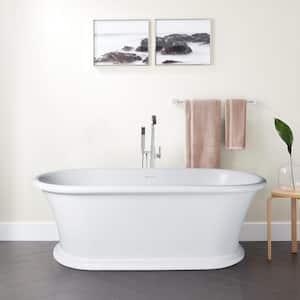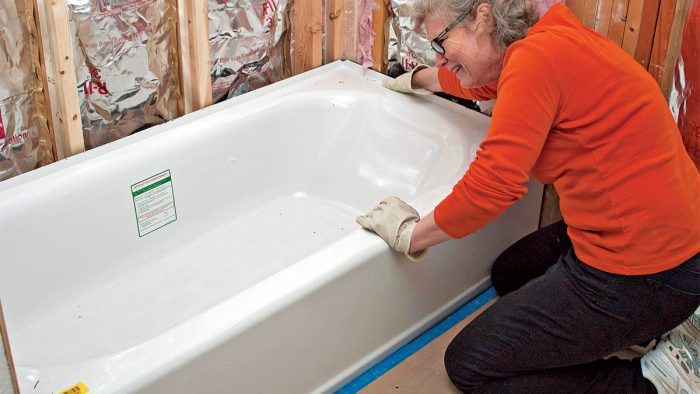Plumbing Basics: The First Step for When Installing a Bathtub
Plumbing Basics: The First Step for When Installing a Bathtub
Blog Article
This great article below on the subject of How to Install a Bathtub Yourself is without a doubt informative. Don't skip it.

Setting up a tub isn't precisely brain surgery, but it does call for strong plumbing, woodworking, and sometimes, tiling skills. Replacing an old bathtub with a new one is also a moderately challenging task. If the old bathtub is conveniently obtainable, the project can move rapidly; if you have to open a wall to eliminate the old tub and also place the brand-new tub, the task is much harder. In either instance, the task is within a house handyman's skills, although you will need an assistant to leave the old tub and also embeded in the new one. Make sure you have actually qualified yourself for the work and also are comfortable trying it. Instead of hiring a contractor to take control of a halfway-completed project, it is far better to consider using one before you begin. Chances are you might require an expert plumber to make tube links.
This article will certainly help you mount a new bathtub in your shower room if you have already acquired a new bathtub as well as don't require to change the plan of your previous water pipelines.
Your tools and material list need to consist of the following:
Removing Old Touches
If you need to change old faucets with new ones as a part of your installation, then the first thing you ought to do is separate the water. After doing so, turn on the taps to drain pipes any type of water remaining in the system. The procedure of removing the existing faucets can be fairly troublesome due to the limited accessibility that is typically the instance.
Utilize a basin wrench (crowsfoot spanner) or a faucet device to reverse the nut that attaches the supply pipes to the faucets. Have a fabric ready for the remaining water that will certainly originate from the pipelines. When the supply pipelines have been gotten rid of, make use of the exact same device to loosen up the nut that holds the faucets onto the bath/basin. You will certainly require to quit the solitary faucets from transforming during this procedure. Once the taps have actually been removed, the holes in the bath/basin will have to be cleaned up of any kind of old securing substance.
Before moving on to fit the brand-new taps, contrast the pipe connections on the old faucets to the brand-new faucets. If the old faucets are longer than the brand-new faucets, then a shank adapter is needed for the brand-new faucets to fit.
Suitable New Taps
If the tails of the new taps are plastic, then you will need a plastic port to prevent damages to the thread. One end of the port fits on the plastic tail of the faucet and also the other end gives a link to the current supply pipelines.
If you need to fit a monobloc, then you will certainly call for decreasing couplers, which connects the 10mm pipe of the monobloc to the common 15mm supply pipe.
Next, position the faucet in the mounting opening in the bath/basin ensuring that the washing machines remain in place in between the faucet and the sink. Secure the tap in place with the producer given backnut. When the tap is securely in place, the supply pipelines can be attached to the tails of the faucets. The taps can either be attached by using corrugated copper piping or with typical faucet ports. The former type must be linked to the tap finishes initially, tightening up just by hand. The supply pipes can later be linked to the various other end. Tighten both ends with a spanner after both ends have been connected.
Setting up the Tub
Making use of the two wooden boards under its feet, put the bathtub in the called for position. The wood boards are helpful in evenly spreading out the weight of the bath tub over the area of the boards rather than concentrating all the weight onto 4 tiny factors.
The next objective is to ensure that the tub is leveled all round. This can be accomplished by inspecting the level as well as readjusting the feet on the bathtub until the level reviews level.
To install faucets, fit all-time low of the furthest flexible tap connector to the appropriate supply pipe by making a compression sign up with; after that do the very same for the other tap.
Turn on the water as well as inspect all joints as well as new pipework for leaks and tighten them if essential. Fill up the tub and additionally examine the overflow outlet and the regular electrical outlet for leakages.
Lastly, repair the bathroom paneling as explained in the producer's user's manual. Tiling and securing around the tub must wait until the bathtub has actually been made use of at least once as this will settle it right into its last placement.
Planning for the Installment
Firstly, the supporting structure provided with the bathroom needs to be fitted (if required) according to the supplier's instructions. Next, fit the faucets or mixer to the bathtub. When fitting the tap block, it is necessary to ensure that if the faucet features a plastic washer, it is fitted between the bathroom as well as the faucets. On a plastic bathroom, it is additionally sensible to fit a supporting plate under the faucets system to stop pressure on the bath tub.
Fit the adaptable faucet adapters to the bottom of both faucets utilizing 2 nuts as well as olives (often supplied with the tub). Fit the plug-hole electrical outlet by smearing mastic filler round the sink outlet opening, and after that pass the electrical outlet through the hole in the bath. Make use of the nut supplied by the maker to fit the plug-hole. Check out the plug-hole electrical outlet for an inlet on the side for the overflow pipe.
Next, fit the end of the flexible overflow pipeline to the overflow electrical outlet. Afterwards, screw the pipe to the overflow face which should be fitted inside the bath. Make sure you utilize all of the supplied washing machines.
Connect the catch to the bottom of the waste outlet on the tub by winding the string of the waste outlet with silicone mastic or PTFE tape, and screw on the trap to the electrical outlet. Attach the bottom of the overflow tube in a similar manner.The bathroom need to now be ready to be suited its last setting.
Tiling Around the Bath tub
In the location where the bathroom meets the tile, it is required to secure the joins with a silicone rubber caulking. This is important as the installation can relocate enough to crack an inflexible seal, creating the water to pass through the wall in between the bathroom and also the tiling, leading to complications with dampness and also feasible leaks to the ceiling below.
You can choose from a variety of coloured sealers to blend in your fixtures and also fittings. They are marketed in tubes as well as cartridges, and can securing gaps approximately a width of 3mm (1/8 inch). If you have a bigger space to fill, you can fill it with twists of drenched paper or soft rope. Bear in mind to always fill the bathtub with water before sealing, to enable the motion experienced when the bathtub is in use. The sealant can crack fairly early if you do not take into consideration this motion before sealing.
Conversely, ceramic coving or quadrant floor tiles can be made use of to border the bathroom or shower tray. Plastic strips of coving, which are easy to use as well as reduce to size, are also conveniently offered on the marketplace. It is advisable to fit the tiles utilizing water-resistant or waterproof adhesive and also grout.
Bathtub Installation
How Important Is A Bathtub To Your Home?
High-quality baths, showers, and other bathroom updates are necessary when considering a smart investment in your home. It’s a room that you go to every day and one that is constantly being used by guests.The bathroom is one of the top trafficked rooms in a home and also one of the most valuable in terms of home resale.
Install Piping Before Tub
You will be using your existing drain and waste vent system, but pipes required include the hot and cold water supply lines and a pipe leading to a shower head. A mixing valve and shower head are also needed. Air chambers may be required.
Position the Tub
Lower the tub into place so that the continuous flange fits against the wall studs and rests on 1’x4' or 2’x4' supports. Anchor the tub to the enclosure with nails or screws inserted through the flanges into the studs.
NOTE: Remember, bathtubs and shower stalls may require support framing. A bathtub filled with water is extremely heavy, so check building codes and framing support before installing the tub.
Assemble Drain Connections
Assemble the bathtub drain connections by connecting the tub overflow with the tub drain above the trap, not beyond it. The trap will have a compression fitting that screws over the arm of the overflow assembly.
Place a Pipe For the Shower Head
First, locate a brass female threaded winged fitting and attach it to a framing support via a screw or a nail. Then run a pipe up the wall for the shower head. Sweat or solder the other side of the brass fitting to the top of the pipe.
Attaching Hot and Cold Water Lines
Attach your water lines for both hot and cold by sweating these directly into the hot and cold ports of the mixing valve. The mixing valve will be how water enters the tub’s system, not by the pipes themselves.
Install the Spout
Extend a piece of 1/2 inch pipe, or whichever length is specified in the manufacturer’s instructions, for the tub spout. Sweat on a male threaded fitting at the end of the pipe or use a brass nipple of the proper length and a 1/2 inch cap.
NOTE: At this point you should have your rough-in plumbing work inspected before proceeding further.
Check For Leaks
Restore the water pressure and check the drain connection and the supply pipes for any sign of leaking.
estore the Bathroom Wall
Replace the wall with moisture-resistant drywall as a base for your wall covering. Seal the joints between the wall and your new tub with silicone caulk as protection against water seepage.
https://www.berkeys.com/2016/12/02/bathtub-installation-dallas/

Do you really like reading up on A Step-by-Step Guide to Installing a Bathtub? Make feedback below. We'd be delighted to know your thinking about this blog. In hopes to see you back again before long. Sharing is nice. Who knows, you may be helping someone out. We love reading our article about Tools You Need to Install a New Bathtub .
Schedule Now Report this page